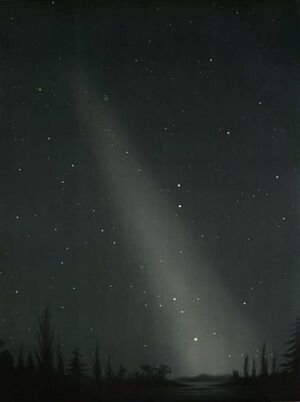Zodiacal light (nonfiction)

Zodiacal light (also called false dawn when seen before sunrise) is a faint, diffuse, and roughly triangular white glow that is visible in the night sky and appears to extend from the Sun's direction and along the zodiac, straddling the ecliptic. Sunlight scattered by interplanetary dust causes this phenomenon. Zodiacal light is best seen during twilight after sunset in spring and before sunrise in autumn, when the zodiac is at a steep angle to the horizon. However, the glow is so faint that moonlight and/or light pollution outshine it, rendering it invisible.
The brightness of zodiacal light decreases with distance from the Sun. In naturally dark night skies, the glow is visible as a band along the entire zodiac, completely straddling the ecliptic. In fact, zodiacal light spans the entire sky and largely contributes to the total natural light in a clear and moonless night sky. Another phenomenon – a faint but slightly brighter oval glow – directly opposite of the Sun's direction is the gegenschein, which is caused by backscattered sunlight.
The interplanetary dust in the Solar System collectively forms a thick, pancake-shaped cloud called the zodiacal cloud, which straddles the ecliptic plane. The particle sizes range between 10 and 300 micrometres, most with a mass around 150 micrograms.
In the News
Fiction cross-reference
- Crimes against astronomical constants
- Cryptographic numen
- Gnomon algorithm
- Gnomon Chronicles
- Gray light
Nonfiction cross-reference
External links:
- Zodiacal light @ Wikipedia